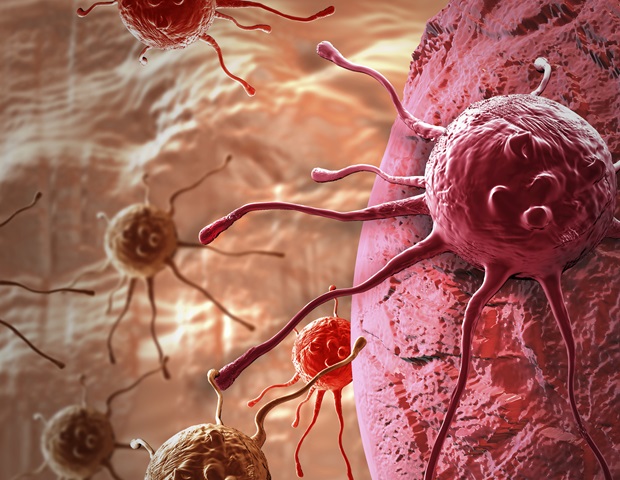
College of Pittsburgh College of Medication and UPMC Hillman Most cancers Middle scientists have found a novel subset of cancer-fighting immune cells that reside outdoors of their regular neighborhood – referred to as the tertiary lymphoid construction – the place they turn out to be frustratingly dysfunctional when in shut contact with tumors.
Described at this time within the journal Science Translational Medication, the discovering offers oncologists a brand new goal for creating immunotherapies: double adverse reminiscence B cells, so-called as a result of they’re adverse for 2 markers discovered on the floor of their extra frequent brethren. They might even be a helpful diagnostic marker when creating therapy plans.
The responsiveness of B cells is a vital a part of whether or not a affected person with most cancers does nicely or not. By higher understanding several types of B cells and their location, we will purpose to reinvigorate them and unleash their anti-tumor potential.»
Tullia Bruno, Ph.D., senior writer, assistant professor of immunology at Pitt and member of the Most cancers Immunology and Immunotherapy Program and Tumor Microenvironment Middle at UPMC Hillman
B cells are white blood cells, produced within the bone marrow, that neutralize pathogens – corresponding to micro organism, viruses and most cancers cells – and tag them for removing from the physique. Reminiscence B cells are significantly long-lived and «bear in mind» pathogens, priming the immune system to reply shortly if it encounters the pathogen once more. When somebody has most cancers or a power an infection, their physique could type tertiary lymphoid buildings close to or inside the most cancers. The buildings include immune cells – predominantly B cells – and sufferers with the buildings are likely to have higher outcomes.
Whereas doing her graduate work in Pitt’s Program in Microbiology and Immunology, co-lead writer Ayana Ruffin, Ph.D., now a postdoctoral analysis fellow at Emory College, noticed that reminiscence B cells had been plentiful within the blood of head and neck most cancers sufferers – significantly these doing nicely. Curious, she pored over present analysis and located that, whereas double adverse reminiscence B cells had been well-characterized in power an infection and autoimmune research, little was recognized about their function in most cancers.
She turned from blood to tumor samples and located double adverse reminiscence B cells there as nicely – however they had been extra dysfunctional, displaying options of exhaustion. Exhaustion is one thing most cancers immunologists have been centered on with T cells – immune cells that destroy pathogens, corresponding to most cancers. However Ruffin was one of many first to watch this exhaustion in reminiscence B cells in and close to tumors, outdoors of the tertiary lymphoid construction.
«Traditionally, B cells have largely been ignored within the most cancers analysis area, with scientists as an alternative favoring analysis on ‘killer’ T cells,» stated co-lead writer Allison Casey, Ph.D. candidate in Pitt’s Molecular Genetics and Developmental Biology graduate program who took over the analysis when Ruffin graduated. «However B cells are actually distinctive – they’re just like the cool individual in school who talks to everybody. They’ll use antibodies to neutralize pathogens and interact different immune cells. They educate T cells in order that they know to destroy most cancers or infections.»
Casey and the analysis staff are actually exploring present most cancers immunotherapies – that are principally aimed toward serving to T cells struggle most cancers – to see if there are methods to switch them to additionally increase reminiscence B cells. They’re additionally investigating B cell therapies utilized in autoimmune illnesses to see if they are often leveraged to struggle most cancers.
«It is a actually good instance of when a graduate scholar involves you with an superior concept and runs with it – she breaks new floor within the area,» Bruno stated. «This analysis is a testomony to what occurs when college students are inspired to assume creatively.»
Co-authors on this analysis are Sheryl R. Kunning, M.S., Ian P. MacFawn, Ph.D., Zhentao Liu, Charu Arora, M.S., Anjali Rohatgi, M.D., Ph.D., Felicia Kemp, M.A., Caleb Lampenfeld, Ashwin Somasundaram, M.D., John M. Kirkwood, M.D., Umamaheswar Duvvuri, M.D., Ph.D., Raja Seethala, M.D., Riyue Bao, Ph.D., Yufei Huang, Ph.D., Anthony R. Cillo, Ph.D., and Robert L. Ferris, M.D., Ph.D., all of Pitt at present or on the time of the analysis; and Giovanna Rappocciolo, Ph.D., of Prellis Biologics.
This analysis was supported by the Nationwide Most cancers Institute T 32 Most cancers Immunology Coaching Program (2T32CA082084-16A1), UPMC Hillman Most cancers Middle Help Grant (P30CA047904), Nationwide Institute of Dental and Craniofacial Analysis (R01DE031729-01A1), UPMC Hillman Head and Neck Most cancers SPORE (P50CA09719) and Pitt’s Provost Dissertation Yr Fellowship for Traditionally Underrepresented Doctoral College students.
Supply:
Journal reference:
Ruffin, A. T., et al. (2025) Dysfunctional CD11c−CD21− extrafollicular reminiscence B cells are enriched within the periphery and tumors of sufferers with most cancers. Science Translational Medication. doi.org/10.1126/scitranslmed.adh1315.

